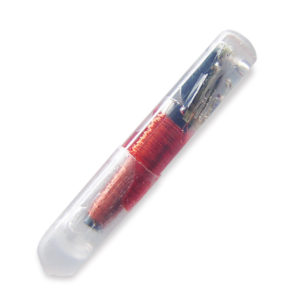The other day I was finalizing an adoption for a dog and the adopter (who has had multiple dogs in the past) asked me why her new dog was microchipped. Our conversation led me to realize that microchips, which have been around for less than 30 years, are a bit of a mystery for many dog owners — both first timers and veterans! So with that, here are 10 questions about microchips (maybe they’re even frequently asked!) and answers for ya….
1. What is a microchip?
A microchip is tiny (about the size of a grain of rice) implant that is placed under a pet’s skin, usually between the neck and shoulder blades. It has a unique identification number on that can be scanned by a microchip scanner, which most animal control officers, animal shelters, and vet offices keep with them.
2. What kind of pets can be microchipped?
The pets most commonly microchipped are dogs and cats, but I know someone who has even microchipped their tortoise!
3. How is a microchip implanted?
Implanting a microchip underneath a dog or cat’s skin is a very simple, affordable procedure that can be done by a veterinary technician or shelter staff. As quick (and painless) as a routine vaccination, a simple tool is used while the dog is held steady for a few moments.
4. What is the point of a microchip?
Unlike collars with tags, a microchip is a permanent form of identification for your pet that cannot fall off or become illegible, for instance. This is often critical for lost pets and the difference between being lost and found.
5. What happens once a lost pet’s microchip is scanned by a microchip scanner?
When a pet’s microchip number is scanned, that number is then typed in to the online microchip registries (there are a few of these, but the most commonly used are AHAA and Found Animals) and a registered microchip will turn up the owner’s name and contact info. If a microchip is not registered — meaning a microchip was implanted under the pet’s skin but the owner did not take the time to register that chip online — then, unfortunately, the microchip is useless. This is why it is imperative to make sure your pet’s microchip is registered, and kept updated if you move, change your phone number, etc!
6. Do all pets adopted from a shelter or rescue come with a microchip?
It’s generally considered best practice for a shelter or rescue group, assuming they have the resources, to microchip the pets they adopt out. That said, it is common but not universal. Most of the shelters and rescue groups I have worked with over the years do microchip before adoption, and transfer the microchip registration over to the new owner when the adoption contract is signed or after a short trial period. Some organizations stay registered on the microchip as a “secondary contact” in case the pet goes missing and the owner cannot be reached due to outdated contact information.
7. If my dog is microchipped, does he still need to wear a collar with identification tags?
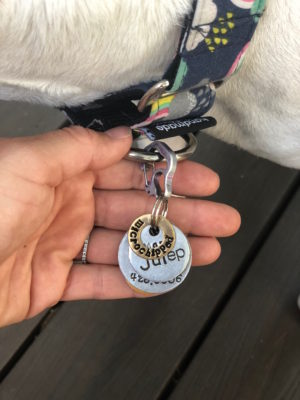
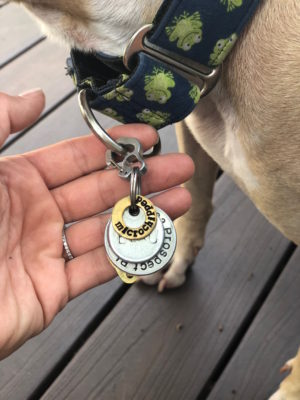 Absolutely! Think about if you’ve ever found a dog. What’s the first thing you look for? A collar with an identification tag, right? It’s usually only when there isn’t one that a microchip comes into play — best case scenario is that the tag has a current phone number and you’re able to get the owner on the phone very quickly! Our dogs actually wear a small tag that says “microchipped,” as well, just in case their identification tag is rubbed off or difficult to read should they ever become lost (hopefully not!) Some microchip companies provide these tags, but we ordered ours from this Etsy seller.
Absolutely! Think about if you’ve ever found a dog. What’s the first thing you look for? A collar with an identification tag, right? It’s usually only when there isn’t one that a microchip comes into play — best case scenario is that the tag has a current phone number and you’re able to get the owner on the phone very quickly! Our dogs actually wear a small tag that says “microchipped,” as well, just in case their identification tag is rubbed off or difficult to read should they ever become lost (hopefully not!) Some microchip companies provide these tags, but we ordered ours from this Etsy seller.
8. How do I register my pet’s microchip, or update the information that comes up when it is scanned?
Whoever implants your pet’s microchip (a vet’s office, shelter, or rescue group, most likely) should give you a piece of paper with the microchip number on it and the brand of microchip and the company’s website. (Brands include 24PetWatch, Found Animals, Home Again, PetLink, Smart Tag, and others.) Visit that website, and register your pet’s microchip. Whenever you move, change your phone number, etc. you will need to go to that same website and update your information.
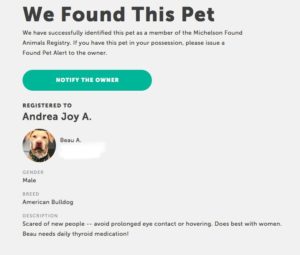
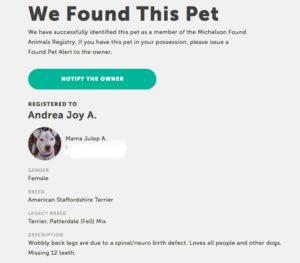 Pro tip: Found Animals is a FREE universal microchip registry where you can register your pet’s microchip regardless of brand. You can also add helpful information like your pet’s photo, if they need medication, special instructions about any behavior quirks, etc. It’s a great idea to register your pet’s microchip on this registry. These are photos of what comes up when Beau and Mama Julep’s microchip numbers are plugged into the Found Animals registry.
Pro tip: Found Animals is a FREE universal microchip registry where you can register your pet’s microchip regardless of brand. You can also add helpful information like your pet’s photo, if they need medication, special instructions about any behavior quirks, etc. It’s a great idea to register your pet’s microchip on this registry. These are photos of what comes up when Beau and Mama Julep’s microchip numbers are plugged into the Found Animals registry.
9. Is a microchip a GPS tracker?
No. It is a common misperception that microchips are GPS-enabled. A microchip will not tell you where your pet is. A microchip is only helpful for locating a pet if that pet is picked up and scanned by a microchip.
10. What should I do if I find a dog that does not have a collar on?
Call animal control or your local animal shelter. Many people think that they are helping by holding on to a dog in their home where they believe he is most comfortable and safe, rather than bringing him to a shelter. But, the fact is that people who have lost their dogs know to call the local animal shelter or animal control officers to find their loved one. Just as important, a shelter or animal control officer should have access to a microchip scanner, to further expedite the reunion.

